


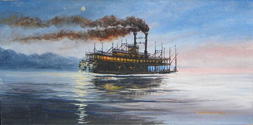

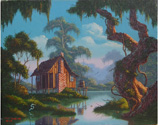
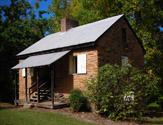









Southern Exposure
Doug Young
South Carolina Artist Passionate About Sculpture
South Carolina Artist Passionate About Sculpture
When one thinks of sculpture, particularly figurative sculpture, artists and works ranging from Michelangelo and his David and Pietà to Rodin and his The Thinker and The Kiss probably come to mind instantly. If one were to randomly inquire about contemporary American sculpture, however, only academicians, connoisseurs and critics could likely produce a list-- one that would inevitably contain Charles Parks, Sabin Howard, Brian Craig-Wankiiri and Christopher Schulz -- of today's finest sculptors. Still, casual observers might even be surprised to discover that some of the nation's most gifted sculptors are found not in the major art enclaves of New York, Los Angeles and San Francisco but in the American South. One southern-based sculptor of note is Indiana native Doug Young.
Young and his wife, Susan, reside just outside of Greenville, South Carolina, and his studio is located in the suburb of Taylors. Influenced by the Renaissance and Modern Classicism, Young has been sculpting for almost three decades. His work can be found in both public spaces and private collections. With a diverse and distinguished portfolio containing bronze, stone and clay figures that vary from mythological and religious to historic and heroic, Young joins the ranks of Atlanta's Martin Dawe and North Carolina's Stephen H. Smith. His best known work is 'Shoeless' Joe Jackson, the life-size statue of Greenville's own major league baseball great.
Young has even embarked on a journey into the world of abstract art with the completion of his first major abstract sculpture. Point of Departure is located on the grounds of The Brio, a six-floor postmodern condominium building at the corner of downtown Greenville's Pearl and South Church streets.
Recently, Young took time out of his busy schedule to expound on his work and relate how sculpting is not merely a creative means to an end for him. Rather, it is a means by which he captivates the beholder, evoking thought and emotion. And he does so with skill and enthusiasm.
Young and his wife, Susan, reside just outside of Greenville, South Carolina, and his studio is located in the suburb of Taylors. Influenced by the Renaissance and Modern Classicism, Young has been sculpting for almost three decades. His work can be found in both public spaces and private collections. With a diverse and distinguished portfolio containing bronze, stone and clay figures that vary from mythological and religious to historic and heroic, Young joins the ranks of Atlanta's Martin Dawe and North Carolina's Stephen H. Smith. His best known work is 'Shoeless' Joe Jackson, the life-size statue of Greenville's own major league baseball great.
Young has even embarked on a journey into the world of abstract art with the completion of his first major abstract sculpture. Point of Departure is located on the grounds of The Brio, a six-floor postmodern condominium building at the corner of downtown Greenville's Pearl and South Church streets.
Recently, Young took time out of his busy schedule to expound on his work and relate how sculpting is not merely a creative means to an end for him. Rather, it is a means by which he captivates the beholder, evoking thought and emotion. And he does so with skill and enthusiasm.
Greg Freeman: First of all, I understand you're from Central Indiana or suburban Indianapolis. How did you wind up in South Carolina? And how long have you been here in the South?
Doug Young: I came to South Carolina to attend college, and I've just stayed in the South. After graduation, I taught high school in North Carolina for about 12 years and then moved to Greenville for a job. I've been here about 18 years, so I've lived in the South about 30 years. That's most of my life.
Greg: Has the American South had any impact on your body of work?
Doug: Both of my parents are from Kentucky. One of my grandfathers, who lost his eye to the coal mine, was a woodcarver. When I was a child I'd go to his basement and look at all the canes, birds, and moving wooden gadgets that he'd made. I wish I had some of his work. His folk art style carvings made a lasting impression on me. As a child, I was fascinated by them. Still am.
I learned to sculpt here in the South. Many years ago I took my first real sculpting class in North Carolina at the local community college.
Of course, I'm also influenced by local artists. The two sculptors I'm in contact with the most are Charlie Pate and Ryan Calloway. Charlie does figurative work and has his studio right across the street from mine. Ryan's a blacksmith, who also does abstract pieces. Ryan was a great help when I was working on Point of Departure. Ryan's a wealth of knowledge when it comes to working with metals.
Greg: While you have proven capable of excelling in a variety of disciplines---from drawing to sculpting---you are best known as a sculptor. Would you say that you are at your creative best when sculpting? Why are you so passionate about sculpture?
Doug Young: I came to South Carolina to attend college, and I've just stayed in the South. After graduation, I taught high school in North Carolina for about 12 years and then moved to Greenville for a job. I've been here about 18 years, so I've lived in the South about 30 years. That's most of my life.
Greg: Has the American South had any impact on your body of work?
Doug: Both of my parents are from Kentucky. One of my grandfathers, who lost his eye to the coal mine, was a woodcarver. When I was a child I'd go to his basement and look at all the canes, birds, and moving wooden gadgets that he'd made. I wish I had some of his work. His folk art style carvings made a lasting impression on me. As a child, I was fascinated by them. Still am.
I learned to sculpt here in the South. Many years ago I took my first real sculpting class in North Carolina at the local community college.
Of course, I'm also influenced by local artists. The two sculptors I'm in contact with the most are Charlie Pate and Ryan Calloway. Charlie does figurative work and has his studio right across the street from mine. Ryan's a blacksmith, who also does abstract pieces. Ryan was a great help when I was working on Point of Departure. Ryan's a wealth of knowledge when it comes to working with metals.
Greg: While you have proven capable of excelling in a variety of disciplines---from drawing to sculpting---you are best known as a sculptor. Would you say that you are at your creative best when sculpting? Why are you so passionate about sculpture?
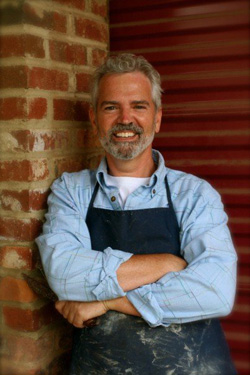
South Carolina artist Doug Young has been sculpting for almost three decades.
Doug: For me, sculpting is very freeing for both the viewer and the artist. Once a painting is finished, you're pretty well locked into seeing the subject from the artist's point of view. Sculpting is different.
Everything changes in three dimensional works. It changes depending on the way the sculpture is lit or the position from which the viewer sees the work. I guess that's one reason why I love sculpting. I'm trying to express how I feel through my work, all the while knowing that other factors may change how the viewer sees it. I try to focus on the emotion in the piece and let the viewer take it from there.
I say sculpting is freeing, but I admit it can try to control me. Sometimes I get lost in the sculpting process. I get drawn into the work and can sculpt so long that an hour or two has passed and I haven't moved away from the piece. Thinking in the round is more challenging, but for me it's rewarding.
Everything changes in three dimensional works. It changes depending on the way the sculpture is lit or the position from which the viewer sees the work. I guess that's one reason why I love sculpting. I'm trying to express how I feel through my work, all the while knowing that other factors may change how the viewer sees it. I try to focus on the emotion in the piece and let the viewer take it from there.
I say sculpting is freeing, but I admit it can try to control me. Sometimes I get lost in the sculpting process. I get drawn into the work and can sculpt so long that an hour or two has passed and I haven't moved away from the piece. Thinking in the round is more challenging, but for me it's rewarding.
Greg: Typically, your creations have fallen into the category of representational artwork? In laymen's terms, what is representational art?
Doug: By "representational works" I mean that they represent what they are supposed to be. If it's to be a person, it's recognizable as a person. It represents what it is. I enjoy figurative works because the human figure can communicate through the pose as well as facial expression.
Greg: Some might declare that representational works are merely repetitive or unoriginal, given that most subjects---particularly the human figure---have been depicted in virtually every conceivable form or pose. What are your thoughts on that?
Doug: By "representational works" I mean that they represent what they are supposed to be. If it's to be a person, it's recognizable as a person. It represents what it is. I enjoy figurative works because the human figure can communicate through the pose as well as facial expression.
Greg: Some might declare that representational works are merely repetitive or unoriginal, given that most subjects---particularly the human figure---have been depicted in virtually every conceivable form or pose. What are your thoughts on that?
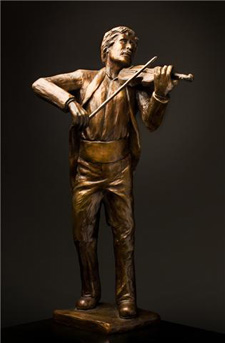
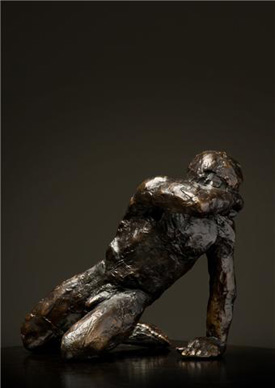
The Maestro, bronze edition of 9, 22" high.
Fallen, bronze.
Doug: People are fascinating. Everyone is different and using the human for the subject opens up an infinite number of possibilities. Age, gender, ethnicity, occupations, expressions...all are worth exploring. Just as every person is unique, so is the creation of every sculpture.
I think most representational artists try to use the figure to present a new idea or, at least, present sculpture that is unique to them. It's very similar to a composer who uses basic principles of music theory that have existed for centuries to create new work. He may have a preference to a particular genre of music, but a good composer can communicate with his audience. He can touch hearts.
Like music without words, I believe good art communicates without words. No explanation is needed. The viewer should be able to relate, feel the emotion, understand the basic concept. Everyone is uniquely created. Everyone has a story to communicate. I just try to bring a moment to life and communicate. I guess I'm just a communicator.
Greg: Don't you think there is still something to be said of an artist's own interpretation of a subject? I would think that five different sculptors could easily render five distinctly different likenesses of the same model because of their own styles, techniques and elements of self-expression. Do you agree?
Doug: Every artist brings his own skill set, values, preferences, background and interpretation to the sculpture and incorporates that into his work. Five different artists will produce five different works. While there are basic principles of form and balance, and the medium may dictate certain parameters, every sculptor interprets the subject differently.
Greg: I would also think that representational artwork is not always equated with realism. Realism, or anatomical correctness, is perhaps essential when creating a bust portrait, but can't a great representational piece evoke a strong sense of emotion without displaying the accurate detailing one normally associates with realistic works? Thinking of your own work, are there sculptures through which you have primarily tried to convey emotion and expression?
Doug: Oh, sure. I think artists can represent something without developing all of the details. Rodin is a great example. You can look at his work and know it's a person and feel the emotion he wanted to convey. Most of his works were considered loose as far as detail, but he communicated the emotion without replicating every detail. I like his work for that reason. I've found myself leaning toward more loose textures and interpretations.
When I think about emotion in my sculptures, the first piece that comes to mind is Gethsemane. I spent a lot of time thinking about the emotion and worked hard to convey the idea of agony. Frankly, I hope all of my sculptures convey some kind of emotion.
I think most representational artists try to use the figure to present a new idea or, at least, present sculpture that is unique to them. It's very similar to a composer who uses basic principles of music theory that have existed for centuries to create new work. He may have a preference to a particular genre of music, but a good composer can communicate with his audience. He can touch hearts.
Like music without words, I believe good art communicates without words. No explanation is needed. The viewer should be able to relate, feel the emotion, understand the basic concept. Everyone is uniquely created. Everyone has a story to communicate. I just try to bring a moment to life and communicate. I guess I'm just a communicator.
Greg: Don't you think there is still something to be said of an artist's own interpretation of a subject? I would think that five different sculptors could easily render five distinctly different likenesses of the same model because of their own styles, techniques and elements of self-expression. Do you agree?
Doug: Every artist brings his own skill set, values, preferences, background and interpretation to the sculpture and incorporates that into his work. Five different artists will produce five different works. While there are basic principles of form and balance, and the medium may dictate certain parameters, every sculptor interprets the subject differently.
Greg: I would also think that representational artwork is not always equated with realism. Realism, or anatomical correctness, is perhaps essential when creating a bust portrait, but can't a great representational piece evoke a strong sense of emotion without displaying the accurate detailing one normally associates with realistic works? Thinking of your own work, are there sculptures through which you have primarily tried to convey emotion and expression?
Doug: Oh, sure. I think artists can represent something without developing all of the details. Rodin is a great example. You can look at his work and know it's a person and feel the emotion he wanted to convey. Most of his works were considered loose as far as detail, but he communicated the emotion without replicating every detail. I like his work for that reason. I've found myself leaning toward more loose textures and interpretations.
When I think about emotion in my sculptures, the first piece that comes to mind is Gethsemane. I spent a lot of time thinking about the emotion and worked hard to convey the idea of agony. Frankly, I hope all of my sculptures convey some kind of emotion.
Greg: You are best known for 'Shoeless' Joe Jackson, the centerpiece of Shoeless Joe Jackson Plaza on South Main Street in Greenville's historic West End. Certainly, an untold number of people view this sculpture every year because of its prominent location and proximity to West End Field, but your body of work has included a variety of sculptures in addition to life-size pieces like 'Shoeless' Joe Jackson. Tell me about some of your other works. Mythological figures and classic nudes make up a good portion of your works, right?
Doug: I enjoy all kinds of work. It doesn't matter to me whether the figures are historic or mythological as long as it communicates something to the viewer.
When I'm not doing a commissioned piece, I'm free to explore. Many of the ideas for my work come from visitors to my studio. Sometimes they mention something that gets me thinking about a new topic.
I guess all of the classical artists have done mythological figures. I'm no different. The thing I like most about mythological figures is that they are open to interpretation. I don't have to consult books for costume accuracy. I research just enough to know the story and then go from there.
Greg: Among your works is the previously mentioned Gethsemane, a piece I find particularly moving. An installation in North Greenville University's prayer garden, this sculpture is an artistic interpretation of Christ's prayer in the garden of Gethsemane as related in the Bible. Of course, we know that at the time of his prayer, Jesus was aware of his fate as he earnestly prayed, "O my Father, if this cup may not pass away from me, except I drink it, thy will be done." Through this sculpture, you have captured both a sense of Christ's humanity and holiness as he prayed in anguish and yet humbly submitted to God's will. As a Christian, was Gethsemane a difficult commission? After all, it's one thing to sculpt an athlete's imposing physique or a dancer's motion and grace, but it's a totally different challenge to render such an emotional and religiously significant piece.
Doug: I didn't want to create a "praying hands" Jesus. I wanted to focus on that moment between, "let this cup pass from me" and "not my will, but Thine."
I worked on three or four maquettes (small scale models) and wasn't happy with any of them. I had someone model kneeling, praying, in agony... Nothing worked. Then I went back to the passages of scripture and read the English Version for the Deaf translation. (I use that one to interpret for the hearing impaired at my church.) The thing that caught my eye was how He fell down in agony. I started thinking again about that and developed the sculpture that you see today.
Greg: Recently, you completed Point of Departure, your first important abstract sculpture. Tell me about this piece.
Doug: Basically, it's a 9-ft. metal abstract sculpture that's part sun-catcher and part tribute. Its kind of Briggs meets Mondrian.
The late Herron Briggs, who lived across the street from the Brio, made whimsical wooden creations. [Piet] Mondrian was an artist who did large brightly colored paintings of squares.
My main objective was to get people to look up. I also wanted something that would catch the sun and make interesting shadows on the ground.
Greg: Are you turning exclusively to abstract art? What are the advantages/disadvantages of creating abstract sculpture?
Doug: I'm open to creating more abstract sculpture, but I don't have any plans to turn my back on figurative works. Abstract is certainly less time consuming and less expensive than bronze. It's creative on an entirely different level. For me, figurative pieces capture emotion that communicates something that metal doesn't. The human spirit can be seen through body language as well as facial expression. It's a challenge I like to face.
Greg: Even in this economy, many people understand the advantages of investing in art and the importance of supporting local and regional artists, but they might doubt the affordability of such purchases. Do you strive to offer works that are within reach of a diverse clientele?
Doug: I've had people in my studio who were very surprised that they could afford a sculpture. Not all of my work is bronze, but even my bronze work is comparable to the price of some paintings in the area. When you like a work of art, that purchase can be passed down for generations. Bronze will outlast many lifetimes.
Whether you are in the market for an addition to your collection or eager to learn more about Young and his sculpture, arranging a visit to his studio is sure to prove rewarding. Anyone making Young's acquaintance will find him not only passionate about his work but friendly and engaging. "I'm a sculptor who enjoys people. I know some artists are more reclusive, but I'm a 'people' person," Young concurs. Always eager to share his knowledge, even offering various drawing and sculpting classes at his studio throughout the year, Young says, "It makes me happy to teach. It inspires me when others are learning. I love sculpting, and I really want to share that joy with others." Young concludes, "Whether it's teaching a class or explaining the whole sculpting process, I thrive on interaction with people."
Doug: I enjoy all kinds of work. It doesn't matter to me whether the figures are historic or mythological as long as it communicates something to the viewer.
When I'm not doing a commissioned piece, I'm free to explore. Many of the ideas for my work come from visitors to my studio. Sometimes they mention something that gets me thinking about a new topic.
I guess all of the classical artists have done mythological figures. I'm no different. The thing I like most about mythological figures is that they are open to interpretation. I don't have to consult books for costume accuracy. I research just enough to know the story and then go from there.
Greg: Among your works is the previously mentioned Gethsemane, a piece I find particularly moving. An installation in North Greenville University's prayer garden, this sculpture is an artistic interpretation of Christ's prayer in the garden of Gethsemane as related in the Bible. Of course, we know that at the time of his prayer, Jesus was aware of his fate as he earnestly prayed, "O my Father, if this cup may not pass away from me, except I drink it, thy will be done." Through this sculpture, you have captured both a sense of Christ's humanity and holiness as he prayed in anguish and yet humbly submitted to God's will. As a Christian, was Gethsemane a difficult commission? After all, it's one thing to sculpt an athlete's imposing physique or a dancer's motion and grace, but it's a totally different challenge to render such an emotional and religiously significant piece.
Doug: I didn't want to create a "praying hands" Jesus. I wanted to focus on that moment between, "let this cup pass from me" and "not my will, but Thine."
I worked on three or four maquettes (small scale models) and wasn't happy with any of them. I had someone model kneeling, praying, in agony... Nothing worked. Then I went back to the passages of scripture and read the English Version for the Deaf translation. (I use that one to interpret for the hearing impaired at my church.) The thing that caught my eye was how He fell down in agony. I started thinking again about that and developed the sculpture that you see today.
Greg: Recently, you completed Point of Departure, your first important abstract sculpture. Tell me about this piece.
Doug: Basically, it's a 9-ft. metal abstract sculpture that's part sun-catcher and part tribute. Its kind of Briggs meets Mondrian.
The late Herron Briggs, who lived across the street from the Brio, made whimsical wooden creations. [Piet] Mondrian was an artist who did large brightly colored paintings of squares.
My main objective was to get people to look up. I also wanted something that would catch the sun and make interesting shadows on the ground.
Greg: Are you turning exclusively to abstract art? What are the advantages/disadvantages of creating abstract sculpture?
Doug: I'm open to creating more abstract sculpture, but I don't have any plans to turn my back on figurative works. Abstract is certainly less time consuming and less expensive than bronze. It's creative on an entirely different level. For me, figurative pieces capture emotion that communicates something that metal doesn't. The human spirit can be seen through body language as well as facial expression. It's a challenge I like to face.
Greg: Even in this economy, many people understand the advantages of investing in art and the importance of supporting local and regional artists, but they might doubt the affordability of such purchases. Do you strive to offer works that are within reach of a diverse clientele?
Doug: I've had people in my studio who were very surprised that they could afford a sculpture. Not all of my work is bronze, but even my bronze work is comparable to the price of some paintings in the area. When you like a work of art, that purchase can be passed down for generations. Bronze will outlast many lifetimes.
Whether you are in the market for an addition to your collection or eager to learn more about Young and his sculpture, arranging a visit to his studio is sure to prove rewarding. Anyone making Young's acquaintance will find him not only passionate about his work but friendly and engaging. "I'm a sculptor who enjoys people. I know some artists are more reclusive, but I'm a 'people' person," Young concurs. Always eager to share his knowledge, even offering various drawing and sculpting classes at his studio throughout the year, Young says, "It makes me happy to teach. It inspires me when others are learning. I love sculpting, and I really want to share that joy with others." Young concludes, "Whether it's teaching a class or explaining the whole sculpting process, I thrive on interaction with people."
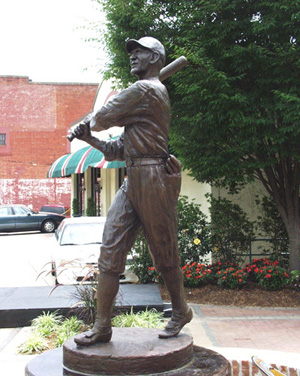
'Shoeless' Joe Jackson, bronze, life-size.
(Located at Shoeless Joe Jackson Plaza, South Main Street, Greenville)
(Located at Shoeless Joe Jackson Plaza, South Main Street, Greenville)
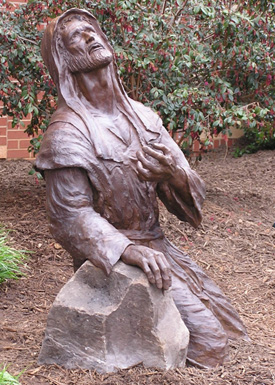
Gethsemane, bronze, slightly larger than life-size.
(Located in the William and Willice P. Anthony Prayer Garden at North Greenville University)
(Located in the William and Willice P. Anthony Prayer Garden at North Greenville University)
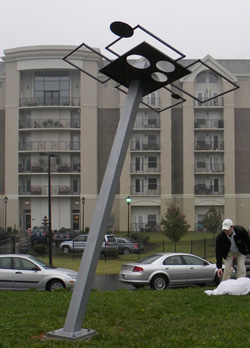
Point of Departure, 9' tall metal.
(This photograph was taken on October 31, 2009 following the sculpture's unveiling at The Brio condominiums in Greenville.)
(This photograph was taken on October 31, 2009 following the sculpture's unveiling at The Brio condominiums in Greenville.)
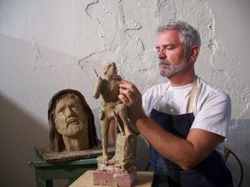
The Artist at Work
SOURCES:
Electronic mail communication with Doug Young on November 17, 2009
Telephone conversation on November 23, 2009
Electronic mail communication with Doug Young on November 17, 2009
Telephone conversation on November 23, 2009
Author: Greg Freeman. Published November 24, 2009.
Copyright
Southern Edition
All Rights Reserved
Southern Edition
All Rights Reserved
All materials contained on this site, including text and images, are protected by copyright laws and may not be reproduced without prior written permission from the publisher. Where applicable, use of some items contained on this site may require permission from other copyright owners.
Fair Use of text from SouthernEdition.com is permitted to the extent allowed by copyright law. Proper citation is requested. Please use this guide when citing a Southern Edition article.
Contact Greg Freeman or SouthernEdition.comFair Use of text from SouthernEdition.com is permitted to the extent allowed by copyright law. Proper citation is requested. Please use this guide when citing a Southern Edition article.